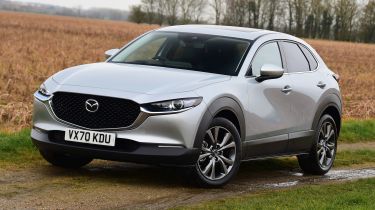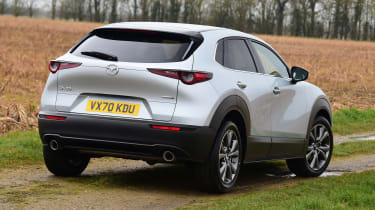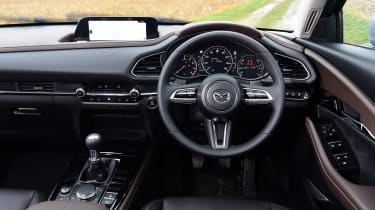Used Mazda CX-30 (Mk1, 2020-date) review: a classy small SUV that’s great to drive
A full used buyer’s guide on the Mazda CX-30 covering the Mk1 model that’s been on sale since 2020
Verdict
Mazda offered a limited choice of powertrains in the CX-30, but with diesel falling out of favour and all-electric available elsewhere within the firm’s range, fitting only mild-hybrid engines makes sense. The result is a car that’s really good to drive, smooth, refined and decently frugal too. In group tests we’ve pitted the CX-30 against the VW T-Roc, Citroen C4 and Kia Xceed, and it’s beaten them. But against the Skoda Karoq, the Mazda came second. In a hugely competitive sector, the engine, transmission and trim level you pick, along with your precise requirements, will make all the difference as to whether the CX-30, or one of its rivals, is best for you. So try plenty of options before choosing.
Mazda has a long history of doing things differently, whether that’s with its design or its engineering. Sometimes this strategy has paid dividends, but on other occasions it has backfired, even if that’s more because of buyers’ conservatism than any problems with the product.
In recent years Mazda has reaped the rewards of building cars that look great, are engaging to drive and have high-quality interiors that are user-friendly and comfortable – and nowhere is this more evident than with the CX-30. Confusingly named, because it slots between the (now discontinued) supermini-sized CX-3 and the larger CX-5, the ‘not-a-CX-4’ is much like its siblings, in that it’s a very desirable small SUV that stands out from the crowd – and has been a hit with new-car buyers.
History
The first CX-30s reached UK showrooms in January 2020. In a segment in which diesel engines were previously very popular, the CX-30 reflected changing consumer tastes, and was available only with a 2.0-litre petrol engine with 121bhp or 177bhp. Both versions were available with six-speed manual or automatic gearboxes, but the lower-output model came only with front-wheel drive; the higher-output edition was offered with front or four-wheel drive.
Used - available now

2022 Mazda
Cx-30
59,027 milesManualPetrol2.0L
Cash £12,800
2022 Mazda
Cx-30
31,614 milesAutomaticPetrol2.0L
Cash £19,995
2022 Mazda
Cx-30
9,850 milesAutomaticPetrol2.0L
Cash £20,287
2022 Mazda
Cx-30
26,706 milesManualPetrol2.0L
Cash £15,000From 1 April 2021, a revised engine was fitted. The 121bhp option remained, with the more powerful variant receiving a boost to 183bhp, with 16Nm of extra torque (to a total of 240Nm). Mazda also claimed slightly lower CO2 emissions, plus a typical lift in fuel economy of around 2.5mpg.
Which one should I buy?
The CX-30 180 has 47 per cent more power than the basic engine, but only 4 per cent more torque (213Nm vs 224Nm), although this is available from 3,000rpm instead of 4,000rpm. Either way, the difference in performance isn’t that noticeable, but the CX-30 180 does have more mid-range shove, which makes it nicer to drive.
All CX-30s are well equipped, the entry-level SE-L having 16-inch alloy wheels, automatic headlights and wipers, power-folding door mirrors, rear parking sensors, a head-up display, air-con, adaptive cruise control, Apple CarPlay and Android Auto.
The SE-L Lux adds front parking sensors and a rear camera, a powered tailgate, heated front seats and dual-zone climate control. The Sport Lux has 18-inch wheels, LED headlights and a sunroof, while the GT Sport also has leather trim, a 12-speaker hi-fi plus a heated steering wheel.
Alternatives to the Mazda CX-30
The CX-30 is up against a long list of rivals, not least the Volkswagen T-Roc, Audi Q2 and Q3, Cupra Formentor, SEAT Ateca and Skoda Karoq, all of which are based on the same basic platform. They’re all desirable, just like the Peugeot 3008, which shares its platform with the Vauxhall Grandland, DS 7 Crossback and Citroen C5 Aircross.
If you want something premium, the BMW X1 and Mercedes GLA might suit, or how about the Lexus UX? All are worth a closer look, as is the Volvo XC40, along with the Range Rover Evoque.
The Ford Puma is another excellent mid-size SUV, and so are the Hyundai Tucson and Kia Sportage. Finally, don’t forget to give the Jaguar E-Pace a try.
What to look for
A bit special
A 100th Anniversary limited edition arrived in 2020; just 100 were sold, in 177bhp form. The only changes were cosmetic.
Cover up
The plastic cover in front of the instrumentation can scratch very easily, just through cleaning, so check that it hasn’t been damaged.
Rattles
Some early editions of the CX-30 suffered from rattles in the front suspension. Mazda redesigned the damper mounts to quieten things down.
Fuel economy
All CX-30s are equipped with Mazda’s M-Hybrid system. This features mild-hybrid tech to improve fuel economy and improve driveability.
Interior
A lot of people think of Mazda as pretty mainstream, but as soon as you sit inside a CX-30, you’ll think of its maker as a premium brand, such is the standard of the materials, the design and the build quality.
There’s a decent balance between buttons and touchscreen commands; separate climate controls below the touchscreen are very welcome, and the dash layout is user-friendly. However, the rear-seat legroom is fairly tight and the transmission tunnel is quite bulky. Boot capacity is merely average rather than impressive, at 430 litres with the back seats in use, or 1,406 litres with them folded down.
Prices
Sport Lux is the most popular trim (accounting for almost a third of the CX-30s for sale), with a quarter being GT Sport; one in six is an SE Lux. The 177bhp engine is more popular than the 121bhp edition (there’s a 60:40 split). Whichever model you choose, you won’t have to break the bank to get a CX-30.
To check prices on a specific model head over to our valuation tool.
Running costs
All CX-30s have to be serviced every 12 months or 12,500 miles. At every service the oil and filter need to be replaced, while in alternate years the brake fluid and pollen filter should be renewed. And every third year you’ll need new air and fuel filters.
There’s no set schedule for the replacement of any other parts; it’s a question of inspecting items such as the drive belts, fuel lines, transmission oil and engine coolant, and changing them only when necessary. Because the CX-30’s engines are chain-driven, there are no cambelts to replace.
The service schedule isn’t all that straightforward, and prices run between £202 (services 1, 5, 7, 11) and £442 (service 6). Along the way, services 3 and 9 are priced at £317, while services 2, 4, 8 and 10 are pegged at £339. Mazda offers service plans, but they have to be taken out within a month of the vehicle being registered.
Recalls
Mazda has recalled the CX-30 twice so far. The first time was in January 2020, when 7,603 Mazda 3s and CX-30s were recalled because faulty software could lead to the auto emergency braking system (or Smart Brake Support in Mazda’s own terms) cutting in unnecessarily. The fault affected CX-30s built up to October 2019, and a software update was all that was needed to fix it.
The second recall was issued in April 2021, and this time only the CX-30 was affected; 7,126 cars were caught up in the campaign, all made between April 2019 and October 2020. Once again the problem was down to software glitches, this time because the powered tailgate could start to lower itself without any input from anyone. Again, a software update was all that was required to put things right.
Driver Power owner satisfaction
Mazda doesn’t feature much in our Driver Power surveys; in our New Car polls, the CX-5 came second last year and ninth in 2023 (out of 75), while the Mazda 3 Mk3 managed 53rd in the 2023 Used Car survey. The CX-5 gives a good indication of what you can expect from the CX-30; owners love the design inside and out, the value, reliability and low running costs. Some of the dynamic elements get the thumbs down.
Looking to sell your current car quickly and for a good price? We’ve partnered with Motorway to bring you the best offer from its network of UK dealers...









